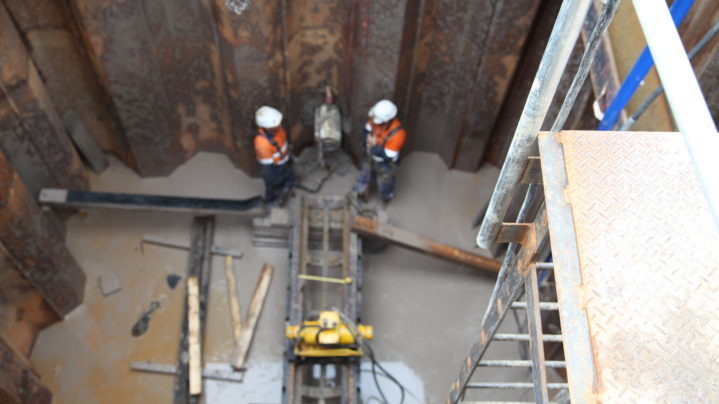Work is nearing completion on the Woolloongabba Sewer Capacity Upgrade, a major project designed to increase the capacity of the sewerage network in the inner Brisbane suburb. Major contractor John Holland has been undertaking various civil works and when extreme accuracy was called for to install the jacking pipe in a few tight spots, they were able to rely on Edge Underground.
Woolloongabba, home to the famous ‘Gabba cricket ground, is an inner suburb to the Southeast of the Brisbane CBD. Changing demographics mean the population is expected to increase by 80,000 in the next few years as high-density apartment living becomes increasingly popular. To ensure infrastructure in the area keeps pace with the population, Queensland Urban Utilities has undertaken a two-phase program, with the first phase being completed in 2011, and the second underway from July 2012 to June 2014.
The program includes the construction of three trunk sewer mains, constructed by a small diameter tunnel boring machine as well as various branch lines. The mains each have a diameter of 1.4 metres and will have a capacity of 5000 litres per second, with an average of 1000 litres per second anticipated. The pipes are built on a gradual decline, dropping one metre for every 800 metres of pipeline.
The project required installation in some particularly tight spots, including installing Hobas 525mm jacking pipe under a major roadway and in high density housing. Extreme accuracy was called for, so JHG called in Edge Underground, regarded by many as the most accurate on-grade sewer contractor in the industry.
Edge Underground specialise in ‘keyhole’ pipeline installation, using highly developed technology to precisely install a pipeline in tight conditions and avoiding the trauma of open cut installation. Edge uses the Vermeer AXIS laser guided boring system, a technology actually developed by Edge founder Stuart Harrison.
They set up on site in July 2013, faced with a very tight working site, requiring them to keep their foot print to an absolute minimum. JHG diverted the live sewer pipes during the procedure, increasing the need for a fast and accurate performance.
The challenge of maintaining this accuracy was magnified by the changing ground conditions, which shifted from wet mud to high plasticity clay. This required Edge to use closed faced cutter to manage the softer un-supporting ground which then made for slow progress through the clay.
But the end result showed that the judgement was right. Edge’s wide experience of similar projects in a large variety of ground conditions has well prepared them to understand the technology and approach required in any situation.
In all Edge completed three bores, of 70 metres, 103 metres and 97 metres. Detailed tests, including as-built survey, vacuum and infiltration tests and CCTV inspection were all carried out and all passed showing accuracy of +/- 10mm for each drive, allowing JHG to have this component signed off by their client shortly after construction was completed.
With these drives completed to everyone’s satisfaction, the final completion of the sewer upgrade is on track.

